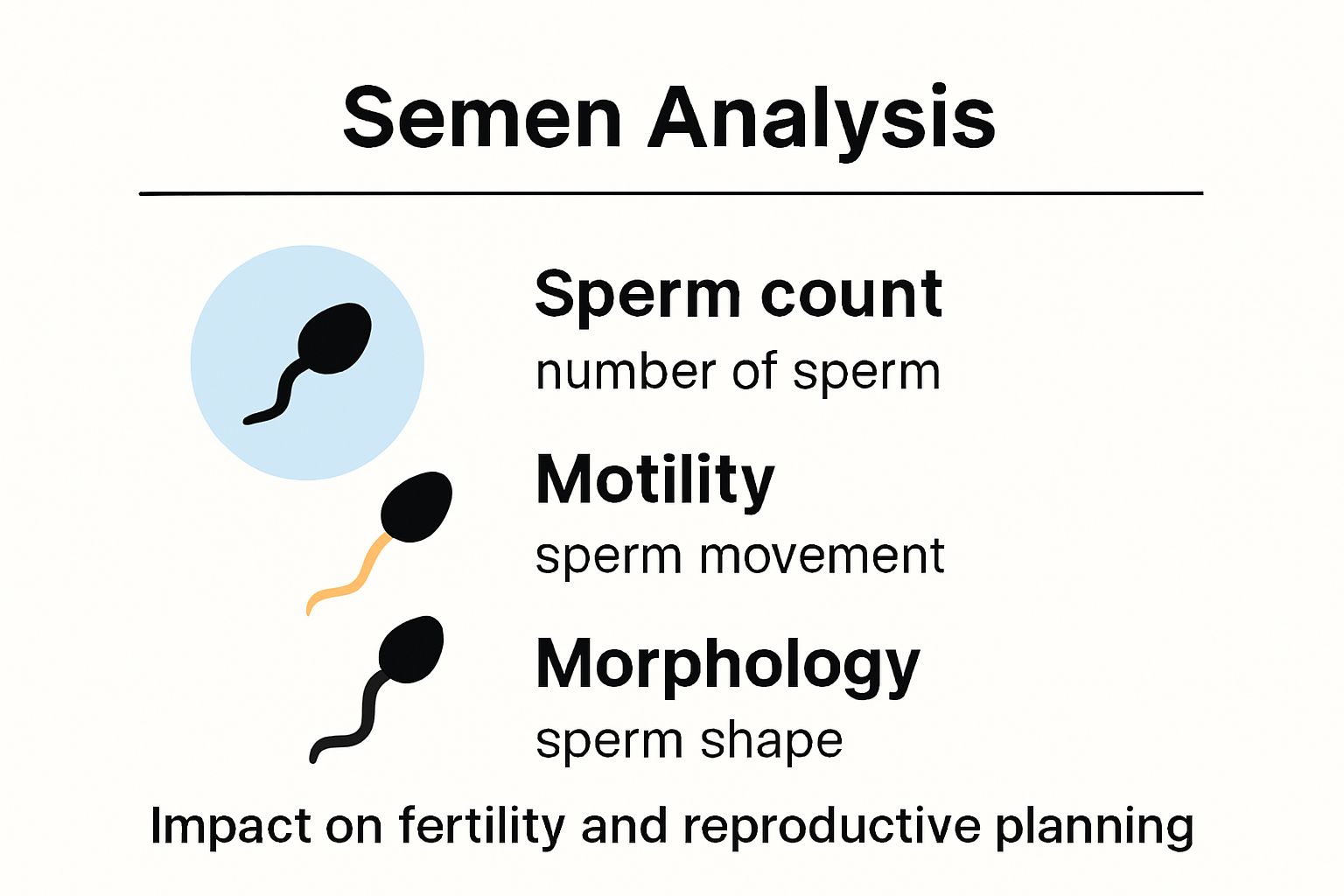Thinking about fertility and family planning keeps getting more advanced each year. Here is a curveball. Only 9.98 percent of sperm in healthy, fertile men are shaped normally according to recent studies. But what really matters is that simple semen analysis can now provide insights not just for conception or after a vasectomy, but for spotting hidden health issues and shaping your future plans. What you find in this test might change the way you think about your health entirely.
Table of Contents
- How Semen Analysis Supports Fertility Goals
- Semen Testing After Vasectomy: What To Expect
- Using Semen Analysis For Effective Family Planning
- Frequently Asked Questions About Semen Analysis And Fertility Planning
Quick Summary
| Takeaway | Explanation |
|---|---|
| Semen Analysis is Crucial for Fertility Planning | It provides detailed insights into sperm health metrics like count, motility, and morphology, which are essential for understanding male fertility potential. |
| Post-Vasectomy Testing is Essential | A semen analysis after 8 to 12 weeks post-vasectomy confirms the success of the procedure by checking for azoospermia or low sperm counts, which ensures effective contraception. |
| Advanced Technology Enhances Accessibility | Modern semen analysis technologies, including at-home testing kits, have made it easier for men to engage with their reproductive health in a comfortable, private setting. |
| Understanding Test Results Benefits Overall Health | Abnormal semen parameters can indicate underlying health conditions, making semen analysis a valuable tool for identifying potential health issues beyond fertility. |
| Psychological Preparedness Matters | Many men experience anxiety regarding semen analysis; open communication with healthcare providers helps mitigate this stress and promotes a proactive attitude toward reproductive health. |
How Semen Analysis Supports Fertility Goals
Semen analysis serves as a critical diagnostic tool for understanding male reproductive health and fertility potential. More than just a simple test, it provides a comprehensive snapshot of sperm characteristics that can dramatically impact conception chances and overall reproductive wellness.

Decoding Sperm Health Metrics
A comprehensive semen analysis examines multiple crucial parameters that directly influence fertility. Sperm count represents the total number of sperm cells in a sample, with normal ranges typically requiring at least 15 million sperm per milliliter. Sperm motility measures the percentage of sperm capable of moving effectively, which is essential for successful fertilization. Morphology assesses the physical structure and shape of sperm, as abnormal shapes can significantly reduce fertility potential.
According to research from Houston Methodist, semen analysis goes beyond fertility assessment. Abnormalities in sperm quality might indicate underlying health conditions, transforming this test from a reproductive screening to a broader health diagnostic tool.
Early Detection and Proactive Planning
Fertility planning requires strategic insights, and semen analysis provides exactly that. Our comprehensive guide on sperm function tests offers deeper insights into how these evaluations can help couples make informed reproductive decisions. Men can identify potential fertility challenges early, allowing time for lifestyle modifications, medical interventions, or alternative conception strategies.
Key factors that semen analysis can reveal include:
- Sperm Production Capacity: Indicates potential challenges in generating sufficient sperm for conception
- Genetic Potential: Provides insights into potential hereditary fertility issues
- Overall Reproductive Health: Serves as a comprehensive health screening tool
For individuals considering vasectomy or confirming post-procedure sterility, semen analysis becomes even more critical. The test verifies the absence of sperm, ensuring the contraceptive procedure’s effectiveness and providing peace of mind.
Modern approaches to semen analysis have transformed from clinical, intimidating experiences to convenient, private assessments. At-home testing kits now allow men to collect samples in comfortable environments, reducing anxiety and increasing participation in reproductive health monitoring.

While technology advances, the fundamental goal remains consistent: empowering individuals with accurate, actionable information about their reproductive potential. Semen analysis represents more than a medical test—it’s a pathway to understanding one’s body, making informed family planning decisions, and taking proactive steps toward reproductive wellness.
Semen Testing After Vasectomy: What to Expect
Undergoing a vasectomy represents a significant decision in reproductive planning, and post-procedure semen testing becomes a critical step in confirming the procedure’s success. Understanding the testing process helps patients navigate this important phase with confidence and clarity.
Timing and Protocol for Post-Vasectomy Testing
After a vasectomy, patients must wait a specific period before conducting a semen analysis. Learn more about optimal test timing, as the waiting period is crucial for accurate results. According to Cleveland Clinic, the recommended timeframe is typically 8 to 12 weeks post-procedure. During this interval, patients are advised to ejaculate multiple times to help clear remaining sperm from the reproductive system.
The American Urological Association provides specific guidelines for successful vasectomy confirmation. Their protocols suggest that azoospermia (complete absence of sperm) or fewer than 100,000 nonmotile sperm per milliliter are reliable indicators of vasectomy success. Persistent higher sperm counts beyond six months might necessitate further medical evaluation.
Sample Collection and Analysis Process
Post-vasectomy semen testing involves precise collection and analysis protocols. Patients can choose between clinical laboratory testing or convenient at-home testing kits. At-home options provide privacy and reduce the anxiety associated with traditional clinical settings. The analysis typically examines several key parameters:
- Sperm Count: Verification of minimal to no sperm presence
- Motility Assessment: Checking for any active sperm movement
- Comprehensive Evaluation: Ensuring complete reproductive system modification
Interestingly, research from Cambridge University Hospitals indicates that a single semen sample can often provide definitive results if it meets strict production criteria. However, some patients might require multiple samples to confirm complete sterility.
Psychological preparation is as important as the physical testing process. Many men experience anxiety about the results, wondering whether the vasectomy was successful. Understanding that this testing is a standard, expected procedure can help alleviate concerns. Patients should communicate openly with healthcare providers and approach the testing phase as a routine confirmation of their reproductive choices.
Modern semen analysis technologies have transformed post-vasectomy testing from a complex medical procedure to a straightforward, accessible process. Whether choosing clinical laboratories or at-home testing options, men now have multiple convenient pathways to confirm their vasectomy’s effectiveness. The key is following recommended guidelines, maintaining patience during the waiting period, and working closely with healthcare professionals to ensure accurate results.
Using Semen Analysis for Effective Family Planning
Family planning has evolved beyond traditional approaches, with semen analysis emerging as a powerful tool for understanding reproductive potential and making informed decisions. This comprehensive diagnostic method provides couples with critical insights into male fertility, helping them navigate the complex journey of conception and reproductive health.
Understanding Fertility Potential
Our comprehensive sperm function guide highlights the importance of detailed semen analysis in family planning. According to the World Health Organization, normal semen parameters include specific benchmarks: 40% sperm motility (with an optimal value of 60%) and 58% live sperm vitality. These metrics provide a crucial baseline for assessing male reproductive capabilities.
Modern semen analysis goes beyond simple counting. Houston Methodist Research suggests that these tests can now serve as comprehensive health screening tools. Abnormal semen parameters might indicate underlying health conditions such as diabetes, cardiovascular issues, or metabolic disorders, transforming fertility testing into a broader health assessment.
Strategic Reproductive Decision Making
Computer-assisted sperm analysis (CASA) has revolutionized fertility planning. Recent studies have established precise reference values for sperm morphology, enabling more accurate diagnostics and improved sperm selection for assisted reproductive technologies. This advancement allows couples to make more informed decisions about their reproductive journey.
Key considerations for effective family planning through semen analysis include:
- Comprehensive Health Insights: Beyond fertility, identifying potential underlying health conditions
- Precision Diagnostics: Using advanced technologies for detailed sperm assessment
- Proactive Planning: Understanding reproductive potential before attempting conception
The psychological aspect of semen analysis cannot be overlooked. For many couples, understanding their reproductive capabilities provides clarity and reduces anxiety. It transforms family planning from a process of hope to a strategy based on scientific understanding.
Technology has democratized access to these insights. At-home testing kits and advanced laboratory techniques have made comprehensive semen analysis more accessible than ever. Couples can now obtain detailed reproductive health information with unprecedented convenience and privacy.
As reproductive science continues to advance, semen analysis stands at the forefront of family planning strategies. It represents more than a medical test—it’s a powerful tool for understanding one’s body, making informed decisions, and taking proactive steps toward creating a family. The future of reproductive health is not about chance, but about informed, strategic planning.
Frequently Asked Questions About Semen Analysis and Fertility Planning
Semen analysis and fertility planning often generate numerous questions for individuals navigating reproductive health. Understanding the nuances of these diagnostic processes can help demystify concerns and empower individuals to make informed decisions about their reproductive journey.
Common Concerns and Diagnostic Insights
Our comprehensive sperm function guide addresses many emerging questions about semen analysis. Notably, research from Cofertility reveals that approximately 10% to 15% of infertile men experience complete absence of sperm (azoospermia), highlighting the critical nature of thorough reproductive health assessments.
Frequently asked questions often center around three primary areas of concern:
- Test Accuracy: Understanding the precision of semen analysis results
- Health Implications: Interpreting potential underlying health conditions
- Next Steps: Determining appropriate actions based on test outcomes
Understanding Test Results and Health Implications
Houston Methodist Research provides critical insights into semen analysis beyond fertility assessment. Their studies indicate that men with fertility challenges have a 30% higher risk of diabetes and a 48% higher risk of ischemic heart disease compared to fertile men. This underscores the importance of viewing semen analysis as a comprehensive health screening tool.
Key questions patients frequently ask include:
- How long does a typical semen analysis take?
- What lifestyle factors can impact sperm health?
- Are at-home testing kits as accurate as clinical tests?
- What do abnormal results mean for my overall health?
Interestingly, recent studies reveal that only about 9.98% of sperm in healthy, fertile men have normal head morphology. This statistic emphasizes the complexity of sperm assessment and the need for comprehensive evaluation.
Patients should understand that semen analysis is not a pass or fail test, but a detailed diagnostic tool providing insights into reproductive and overall health. The results offer a snapshot of sperm quality, motility, and potential underlying health conditions. Abnormal results do not necessarily indicate infertility but rather suggest the need for further investigation and potential lifestyle or medical interventions.
The psychological aspect of semen analysis is equally important. Many individuals experience anxiety about testing, worried about potential implications for their fertility or health. Open communication with healthcare providers, understanding the comprehensive nature of these tests, and viewing them as proactive health management can significantly reduce stress.
Advances in technology have transformed semen analysis from a clinical, intimidating process to an accessible, private, and informative health assessment. At-home testing kits, advanced laboratory techniques, and comprehensive analysis methods have made it easier than ever to gain insights into reproductive health.
Ultimately, semen analysis represents more than a medical test—it’s a powerful tool for understanding one’s body, making informed health decisions, and taking proactive steps toward reproductive wellness. By demystifying the process and understanding its broader implications, individuals can approach fertility planning with confidence and clarity.
Frequently Asked Questions
What is semen analysis and why is it important?
Semen analysis is a diagnostic test that evaluates various parameters of sperm health, including sperm count, motility, and morphology. It is crucial for assessing male fertility potential and can also indicate underlying health issues.
How long after a vasectomy should I wait to perform a semen analysis?
It is recommended to wait 8 to 12 weeks after a vasectomy before conducting a semen analysis. This timeframe allows enough time for any remaining sperm to be cleared from the reproductive system.
What can the results of a semen analysis tell me about my health?
The results of a semen analysis can provide insights into not only fertility potential but also overall health. Abnormal sperm parameters may indicate issues such as hormonal imbalances, diabetes, or cardiovascular problems.
Are at-home semen testing kits as reliable as clinical testing?
At-home semen testing kits can provide reliable results if used correctly. However, clinical laboratory testing typically offers more comprehensive analysis and is considered the gold standard for diagnosing fertility issues.





